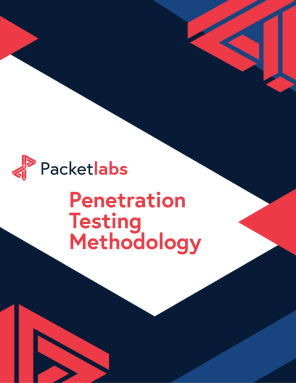Recommendations for Post-Breach Strategies
- The First Post-Breach Step: Notification and Containment
- The Importance of Transparent and Compliant Communication
- 3. Legal, Insurance, and Regulatory Response
- 4. Technical Remediation and Hardening
- 5. Supporting Teams and Preventing Burnout
- 6. Strategic Review and Lessons Learned
- 7. Long-Term Resilience and Multi-Year Oversight
- Conclusion
Would you like to learn more?
Download our Pentest Sourcing Guide to learn everything you need to know to successfully plan, scope, and execute your penetration testing projects.
What are your organization's post-breach strategies?
When cyber roadmaps are truly tested, what separates resilient organizations from those who suffer major financial, reputational, and operational losses isn’t whether they are attacked; instead, it's how they respond afterward.
The first 48 hours of incident response are critical... but true recovery takes far longer. Effective post-breach strategies must extend from immediate containment to multi-year resilience, blending technical fixes with executive, legal, and cultural action.
Let's dive in:
The First Post-Breach Step: Notification and Containment
The first step after detecting a breach is to halt it in its tracks.
For the majority of attacks, this looks like:
Isolating compromised systems to prevent lateral movement
Revoking stolen credentials, reset access tokens, and block malicious IPs
Deploying forensic tools to capture system snapshots and logs before attackers cover their tracks
Forensics isn’t just about identifying what happened: instead, it builds the evidence trail needed for legal proceedings, insurance claims, and regulatory reporting.
The Importance of Transparent and Compliant Communication
A breach is as much about trust as it is about technology. Mismanaging communication can, in some cases, cause more long-term damage than the breach itself.
To circumvent these common communication pitfalls, we advise to enact the following:
Notify regulators, insurers, and local police forces within required timelines (e.g., GDPR’s 72-hour rule, SEC’s 4-day disclosure requirement, Canada’s Bill C-26)
Provide accurate, timely updates to customers and partners to avoid speculation
Keep internal teams informed so employees don’t learn about the breach through the media
Advise internal team members on how to respond to the media if outreach occurs
Transparency demonstrates accountability and helps preserve stakeholder confidence.
3. Legal, Insurance, and Regulatory Response
Breaches trigger a wave of legal and compliance obligations:
Engage legal counsel early to assess liability and disclosure requirements
Notify cyber insurance providers to ensure coverage
Prepare for regulatory inquiries, potential lawsuits, and contractual penalties
This step requires coordination between CISOs, legal teams, compliance officers, and executives all working from the same playbook.
4. Technical Remediation and Hardening
Containment stops the attack, but remediation prevents recurrence.
Patch exploited vulnerabilities and replace compromised systems
Harden identity and access management (MFA, least privilege, Zero Trust)
Improve logging, monitoring, and endpoint detection to close visibility gaps
Audit third-party integrations, which are often weak links in supply chains
This stage is where incident reports turn into concrete, long-term security improvements.
5. Supporting Teams and Preventing Burnout
Breach response pushes cybersecurity teams into overdrive. Without structured recovery, staff burnout becomes a hidden consequence.
Rotate on-call duties to balance workloads
Schedule cooldown periods after high-stress incidents
Provide access to mental health and resilience resources
Organizations that support their teams post-breach retain talent and strengthen long-term readiness.
6. Strategic Review and Lessons Learned
Every breach should end with a lessons learned review.
What detection gaps allowed the breach?
Where did communication break down?
Did the Incident Response Plan (IRP) hold up under stress (or was it outdated?)
This process should result in updated IRPs, refined playbooks, and improved cross-functional training. Tabletop exercises should include recovery scenarios, not just containment.
7. Long-Term Resilience and Multi-Year Oversight
Recovery doesn’t end when systems come back online. For many organizations, regulators may impose multi-year monitoring requirements. Customers and partners may demand independent audits and penetration testing before re-establishing trust.
Long-term strategies include:
Continuous security testing (pentests, red team exercises)
Regular compliance audits
Executive education on cyber risk
Cultural shifts that treat cybersecurity as enterprise risk, not just IT
Conclusion
A breach is not the end of the story: it’s the beginning of a resilience journey. Post-breach strategies must extend beyond patching systems. They require transparent communication, legal and regulatory coordination, team support, and executive-level buy-in.
Handled well, a breach can become a turning point, strengthening defenses, building resilience, and demonstrating to customers and partners that the organization can withstand adversity.
In today’s world, the strongest organizations are not the ones that never fall, but instead are the ones that rise smarter, faster, and stronger after a breach.
Contact Us
Speak with an Account Executive
Interested in Pentesting?

Penetration Testing Methodology
Our Penetration Security Testing methodology is derived from the SANS Pentest Methodology, the MITRE ATT&CK framework, and the NIST SP800-115 to uncover security gaps.
Download Methodology
Pentest Sourcing Guide
Download our Pentest Sourcing Guide to learn everything you need to know to successfully plan, scope, and execute your penetration testing projects.
Download Guide










